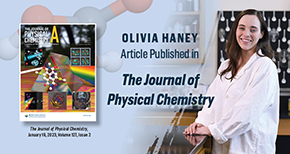
February 16, 2023 (Jackson, Miss.) - The Journal of Physical Chemistry A has published the peer-reviewed research of junior chemistry major Olivia Haney.
“It is rare for an undergraduate student to get a published paper, even for larger research universities,” said Chair and Associate Professor of Chemistry Dr. Brandon Magers. “Many of our chemistry students participate in internships, but Olivia being an author of a peer-reviewed research article, goes above and beyond.Her lab experience, conference participation, and now-published research will make Olivia a top pick for a job or placement into graduate school.”
Dr. Ryan Fortenberry, associate professor of chemistry and biochemistry at the University of Mississippi, was the lead researcher and advisor for this project. Haney worked under Fortenberry and his research team during the summer of 2022.
The research paper, "Red-Shifting the Excitation Energy of Carbonic Acid Clusters Via Nonminimum Structures," focused on carbonic acid. The molecule is difficult to study because it tends to break apart into water and carbon dioxide.
Scientist don't know much about carbonic acid, such as its structure or the shapes of clusters, but that changed a few years ago. A laboratory was able to freeze solid carbonic acid using super cold temperatures. At this temperature, the atoms were stuck as carbonic acid and unable to break apart. The laboratory ran tests on how much light it could absorb but did not study the energy state of carbonic acid. That is where Fortenberry's team focused their efforts.
Haney said, “Using computational chemistry, I was able to generate potential shapes that this frozen carbonic acid could take and what kind of excitation energies it would experience in these shapes.” She would manually manipulate a carbonic acid molecule, such as rotating a bond and changing its angle, then code that rotation into her calculations. Haney would run multiple jobs where "snapshots" of the molecule would be taken, and its energy would be recorded during its rotation.
“The geometric structure of a molecule is very important information because it tells us how it responds to itself, with other molecules, and with its environment,” observed Haney. “This project helped us learn more about the potential geometric structure that carbonic acid is in nature, which is something that has barely been studied.”
After Haney graduates, she wants to go into analytical lab work as a lab technician, and adds, “I love learning about how the world works on a more intricate level. In the Christian worldview, people talk all about the incredible design of the universe. It is so interesting to take on projects and see that complexity with your own eyes. Especially when it's considering ideas and research experiments that have never been conducted before.”
